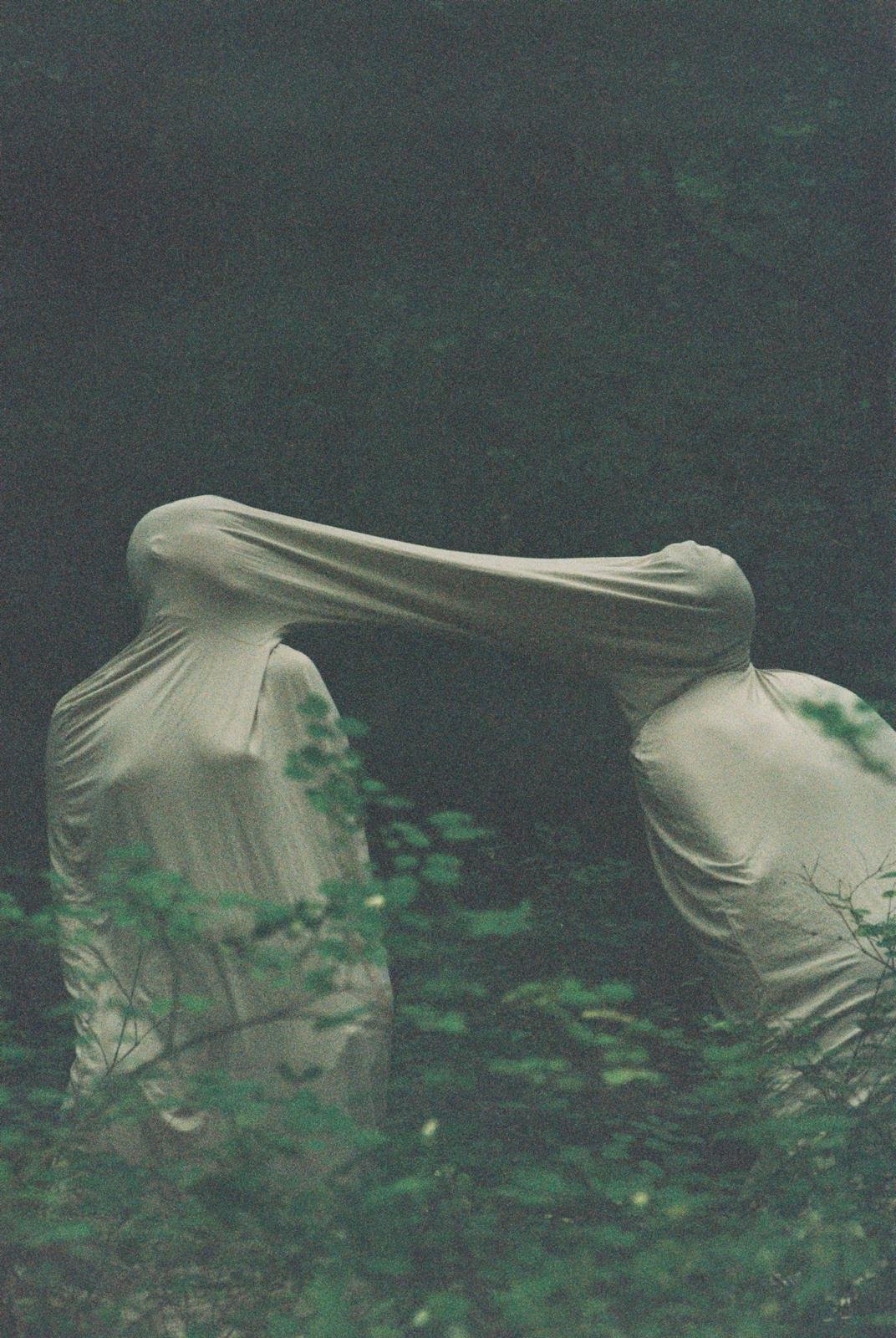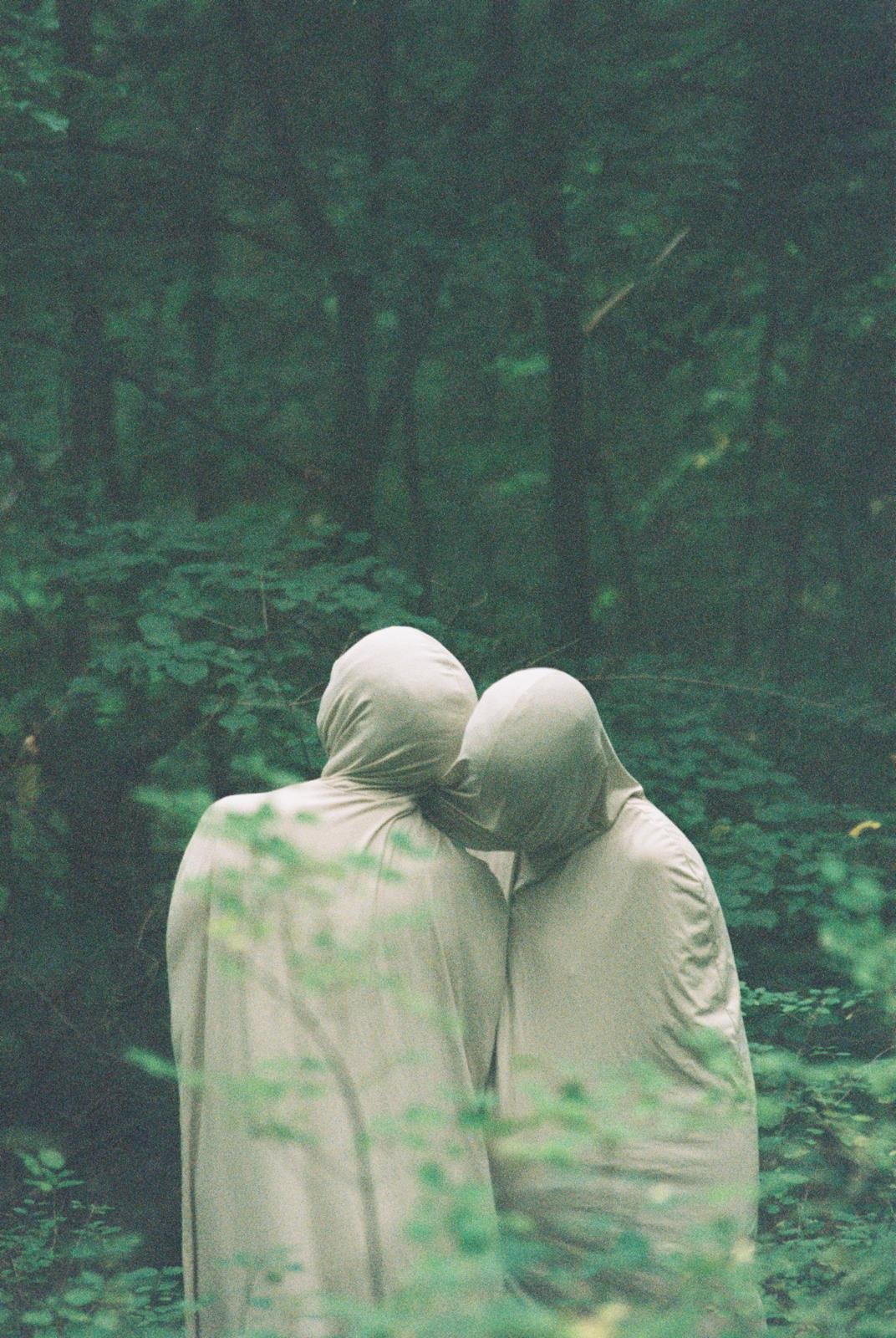A Tuned Body
Research conducted at Countdown Grabowsee art residency in August 2024, co-developed with Madelyn Byrd
A Tuned Body is both performance and methodology – the performed work is, in fact, a vessel for the methodology. In August 2024, we joined a DYI artist residency in Oranienburg for 10 days, over the course of which we manifested the first iteration of the tuning practice and performance.
It began as a speculation on the gradients between ‘self’ and ‘other.’ As two collaborators whose work focuses on queer, ecological, affectual relationships, we wanted to devise a methodology that enables us to fluctuate between being two cooperating individual bodies and one shared, coordinated body. The result is a meditation practice we call ‘tuning’ – a term borrowed from Tim Morton’s All Art is Ecological (2021) – in which we align our bodily and environment awareness and movement. Then, donning multi-wearer garments we created, we inhabit a shared skin – a vessel in which multiple individuals become organs in a composite organism.
Performance
As a performance, A Tuned Body is a movement and sound piece, dramatizing both the process of tuning as well as the maturation cycle of the composite organism. After turning together, inhabit the skins co-become the new, coordinated body. The progression of movement illustrates the exploration of a young creature in the world. Movement builds upon itself as the organism learns its own body’s capabilities. In the performance context, we collaborate with Julie Stamm and others in researching, scoring, and performing this movement. We center improvisation, with the tuning methodology as the container for the score.
With sound artist Scott Carver, we researched working with microphones and voice modulation written in Supercollider code to design a voice for the organism. The resulting sound plays through Carver’s handmade 14-channel surround sound system, engulfing the performers in a cocoon of their own noises. When two or more voices inside the skin merge into the texturized, scintillating, echoing composite voice, the sensation of duet slowly melts into the sensation of soloing. The organism’s sonification not only enhances the otherworldly experience of co-becoming, but also pulls the coder/musician (Carver) into the shared body as yet another organ. As the organism matures, learning its own voice and mind, its sound evolves from breathing, to harmonizing, pre-verbal expression, to utterances of verbalized self-awareness.
When we first began research with performing in multi-body costumes, at the DIY arts residency and festival Countdown Grabowsee in August 2024 (see portfolio), we noticed and received feedback of a connective audience experience. Set in the round, with the audience free to move and modulate the space around the performers, a third body knit itself into form; the audience responded as organs that cooperate as tuned whole, shifting around in the third skin of the built and sonic environment. This transformation of performer vs. audience into a smooth and organic system underscored our need for deeper research and reiteration.
Theoretical Tethers
A Tuned Body sprouts from a complex conceptual net, which traces the ley lines between personal queer and trans experience, intersectional environmentalism, and sympoietic ecology. The methodology of tuning emerged from our curiosity in learning to move in and out of shared consciousness. We live and breathe the rhizomatic nature of queer community in Berlin, in which each person proffers their own self-actualized authenticity, forming a lush creative ecology. We evolve (as queer individuals, and as a queer legacy) in deep entanglement with those in our community as well as with our non-human neighbors and with our environment; this sympoiesis of queer culture is a model which may inspire an Other future vision: one in which flux is embraced, in gender, in perception, in growth and degrowth.
The interrogation of one’s own gender, and the embodied knowledge of gender transition, unlock modes of thought that counter the Western cult of the individual. Global Northern Modernity silos humans in ‘Us vs. Them’ thinking. But when we allow ourselves to become Them, we realize that such separations are a mirage created by hegemony and domination – xenophobia manifested through contemporary colonialisms, capitalism, ecocide, and through queerphobia. Therefore, dissolving the Narrative of Separation (Christian Wahl, 2018) is not only a queer act, but an ecological one, inviting us to see our interrelations within the whole planetary body, and our shared lot in its evolution – when sympoiesis, through engorged scale, becomes an autopoietic entity. As Donna Harraway (2016) terms it, this process of ‘becoming-with’ urges a collaborative future view in which humans no longer dominate the life hierarchy.
Winding back towards our research and worldbuilding of A Tuned Body, we ask: “What might we learn in time spent outside of our individual, human perception? What lessons lie in the experience of being an organ, to contrast our baseline knowledge of being an organism? How might we learn to relate empathically (and emphatically) with the Other?” We therefore position this performance as more than a presentation of creative research through sound and movement; it is a piece of somatic-based storytelling of emergent queer ecologies, of a becoming-with process, which ropes together all who are present. This story makes the room an organism.
About Countdown Grabowsee
The residency takes place in a derelict, rewilded tuberculosis sanatorium built in the late 1800s. Every summer, around 60 artists spend a week in pop-up studio spaces spread across the derelict campus. Our studio was on the top floor of what we called the ‘fundus building,’ with a bright balcony looking into the forest and 3-6 cm of dust and rubble which had to be cleared. Laying down large carpets to contain the stubborn remnant motes, and propping a giant board covered in butcher paper against one wall, we constructed a monastic but cozy home for the day. A spigot by the path below our window soundtracked a constant soft gurgle, and music from our neighbors wafted through our empty doorframe. We spent the week collaborating within our new community, sharing all meals, and offering each other workshops and skill shares throughout the week. The residency culminated with a weekend-long exhibition and party, open to friends and family.
Cited Sources
Haraway, Donna J. Staying with the Trouble: Making Kin in the Chthulucene. Duke University Press, 2016.
Morton, Timothy. All Art Is Ecological. This extract published in Penguin Books. Green Ideas 3. London: Penguin Books, 2021.
Wahl, Daniel Christian. “Why Do We Need to Change the Stories We Live By?” Age of Awareness (blog), September 2, 2018. https://medium.com/age-of-awareness/why-do-we-need-to-change-the-stories-we-live-by-86f454770b01.



